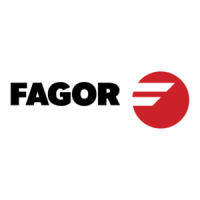Installation manual
CNC 8035
PLC PROGRAMMING EXAMPLE
Main module.
13.
(SOFT M: V15.3X)
(S
OFT T: V16.3X)
·419·
---- Coolant treatment ----
The CNC executes function M08 to turn the coolant on and function M09 to turn it off.
Also, in this case, the operator has a switch to select whether the coolant is activated manually by
the operator or automatically by the CNC.
I-REFMAN The operator control the coolant. Manual mode.
I-REFAUT The operator control the coolant. Automatic mode.
O-REFRIG Coolant on/off output.
I-COOLMA OR (I-COOLAU AND M-08) = O-COOL
Coolant ON.
RESETOUT = NOT O-COOL = RES M-08
The coolant will be turned off when the CNC is reset to initial conditions (RESETOUT) or when
executing functions M00, M02, M09 and M30.
This instruction does not contemplate functions M00, M02, M09 and M30 since the treatment of M,
S, T functions turns mark M-08 off when activating any of them.
----- Treatment of the general CNC input AUXEND -----
It is advisable to have one single instruction to control each one of the logic CNC inputs, thus
preventing undesired functioning.
When having several instructions which can activate or deactivate an input, the PLC will always
assign the result of analyzing the last one of those instructions.
This example shows how to group in a single instruction all the conditions that activate or deactivate
one logic CNC input.
NOT T1 AND NOT M-41 AND NOT M-42 = AUXEND
Input AUXEND will remain low while:
• The "Treatment of the MSTROBE, TSTROBE, STROBE signals" is in progress (timer T1 active)
• A spindle gear change is being performed (M-41, M-42)
----- Keyboard simulation -----
With this example it is possible to simulate the theoretical path of part-program P12 whenever the
operator requests it.
To do this, follow these steps:
• Indicate to the CNC that from now on the keys will come from the PLC.
• Simulate all the necessary steps sending the code of each one of the keys.
• Indicate to the CNC that from now on the keys will be coming from the CNC keyboard, not from
the PLC.
In order to make sending the keys easier, a subroutine is used which utilizes the following
parameters:
ENVIATEC (Send Key) Calling parameter that must be activated whenever a key is to be sent.
CODTECLA (Code of the key) Calling parameter that must contain the code corresponding to the
key being simulated.
ENVIOK (Sent OK) Outgoing parameter indicating that the key code has been sent
successfully.

